A Review of Nanomaterials’ Effect on Mechanical Performance and Aging of Asphalt Mixtures
Abstract
1. Introduction
2. Nanomaterials
2.1. Type of Nanomaterials
2.2. Modification of the Asphalt Binder with Nanomaterials
3. Effect of the Modification with Nanomaterials in the Asphalt Binder
4. Effect of the Modification with Nanomaterials in the Mechanical Performance of Asphalt Mixtures
4.1. Nanosilica
4.2. Nanoclay
4.3. Nanoiron
5. Aging Resistance
5.1. Asphalt Binder
5.2. Asphalt Mixtures
5.2.1. Methods
5.2.2. Nanosilica
5.2.3. Nanoclay
5.2.4. Nanoiron
6. Cost Evaluation
7. Concluding Remarks
- For asphalt mixtures, the modifications with nanosilica present higher Marshall stability, higher indirect tensile strength, higher stiffness modulus, lower permanent deformation, enhanced fatigue resistance, and higher resistance to moisture damage. The studies found in literature covered the dosage range of 0.5% to 8%, and the effects of the modifications increase according with the increase in dosage. Nevertheless, the cost of the modification should be taken into account, as the use of high dosages can return not economical.
- The effects of the modifications with nanoclays were dependent of the type of nanoclay. Besides the particle size distribution and the specific surface area, the type of treatment, raw (hydrophilic) or organically modified (hydrophobic), can have particular importance in the obtained effects. Generally, the effects of nanoclays modifications are higher Marshall stability, lower permanent deformation, higher stiffness modulus at high temperatures, better fatigue resistance, and higher resistance to moisture damage. The studies found in literature covered the dosage range of 1% to 7% and, the effects of the modifications increase according with the increase in dosage. Nevertheless, in the case of some organically modified nanoclays, the performance enhancement peaked at relatively low dosages (e.g. 2%) and a further increase in dosage worsened the performance. As the cost of organically modified nanoclays can be roughly double the cost of raw nanoclay, the use of such modifications should be careful optimized to ensure maximum performance with lowest dosage possible.
- Currently, the modifications with nanoiron are not as explored as those with nanosilica and nanoclays, nevertheless, several studies reported important improvements in the mechanical performance of the modified asphalt mixture, such as, higher Marshall stability, higher indirect tensile strength, higher resistance to moisture damage, lower permanent deformation, enhanced fatigue resistance, and fracture resistance. The optimum dosage of nanoiron particles seems to be in the range of 0.8% to 0.9%, where the performance gains peak and, further increase in dosage worsens the performance. Comparatively to other nanomaterials, the lower optimum dosage of nanoiron particles can make them more competitive from economic point of view.
- Besides the improvements in mechanical performance, the nanomaterials also gave good indications regarding an enhanced aging resistance. The study of the properties of aged asphalt mixtures highlighted the full potential of the nanomaterials and this is a good inference regarding the necessary life cycle cost evaluation in order to achieve a good balance between direct construction costs, high for now due to the use of nanomaterials, and the long term effect on durability.
Author Contributions
Funding
Conflicts of Interest
References
- Hunter, R.N.; Self, A.; Read, J. The Shell Bitumen Handbook, 6th ed.; Shell Bitumen by ICE Publishing: London, UK, 2015. [Google Scholar]
- Carraher, C.E., Jr. Seymour/Carraher’s Polymer Chemistry, 6th ed.; Marcel Dekker: New York, NY, USA, 2003. [Google Scholar]
- Erkens, S.; Porot, L.; Glaser, R.; Glover, C.J. Aging of Bitumen and Asphalt Concrete: Comparing State of the Practice and Ongoing Developments in the United States and Europe. In Proceedings of the Transportation Research Board 95th Annual Meeting, Washington, DC, USA, 10–14 January 2016. [Google Scholar]
- Apostolidis, P.; Liu, X.; Kasbergen, C.; Scarpas, T.A. Synthesis of Asphalt Binder Aging and the State-of-the-Art of Anti-aging Technologies. Transp. Res. Rec. 2017, 2633. [Google Scholar] [CrossRef]
- Porto, M.; Caputo, P.; Loise, V.; Eskandarsefat, S.; Teltayev, B.; Oliviero Rossi, C. Bitumen and Bitumen Modification: A Review on Latest Advances. Appl. Sci. 2019, 9, 742. [Google Scholar] [CrossRef]
- The European Commission. EC Commission Recommendation of 18 October 2011 on the definition of nanomaterial (2011/696/EU). Off. J. Eur. Union 2011, L 275, 38–40. [Google Scholar]
- ASTM International. ASTM E2456-06. Standard Terminology Relating to Nanotechnology; ASTM: West Conshohocken, PA, USA, 2012. [Google Scholar]
- Donegá, C.D.M. (Ed.) The Nanoscience Paradigm: “Size Matters!”. In Nanoparticles: Workhorses of Nanoscience; Spinger: Berlin, Germany, 2014; pp. 1–12. [Google Scholar]
- Steyn, W.J. Applications of Nanotechnology in Road Pavement Engineering. In Nanotechnology in Civil Infrastructure; Gopalakrishnan, K., Birgisson, B., Taylor, P., Attoh-Okine, N.O., Eds.; Springer-Verlag: Berlin/Heidelberg, Germany, 2011; pp. 48–83. [Google Scholar]
- Ezzat, H.; El-Badawy, S.; Gabr, A.; Zaki, E.-S. Evaluation of asphalt enhanced with locally made nanomaterials. Nanotechnologies Constr. 2016, 8, 42–67. [Google Scholar] [CrossRef]
- Yuvakkumar, R.; Elango, V.; Rajendran, V.; Kannan, N. High-purity nano silica powder from rice husk using a simple chemical method. J. Exp. Nanosci. 2014, 9, 272–281. [Google Scholar] [CrossRef]
- Liou, T.H.; Yang, C.C. Synthesis and surface characteristics of nanosilica produced from alkali-extracted rice husk ash. Mater. Sci. Eng. B Solid-State Mater. Adv. Technol. 2011, 176, 521–529. [Google Scholar] [CrossRef]
- Santana Costa, J.A.; Paranhos, C.M. Systematic evaluation of amorphous silica production from rice husk ashes. J. Clean. Prod. 2018, 192, 688–697. [Google Scholar] [CrossRef]
- Ma, X.; Zhou, B.; Gao, W.; Qu, Y.; Wang, L.; Wang, Z.; Zhu, Y. A recyclable method for production of pure silica from rice hull ash. Powder Technol. 2012, 217, 497–501. [Google Scholar] [CrossRef]
- Phoohinkong, W.; Kitthawee, U. Low-Cost and Fast Production of Nano-Silica from Rice Husk Ash. Adv. Mater. Res. 2014, 979, 216–219. [Google Scholar] [CrossRef]
- Moosa, A.A.; Saddam, B.F. Synthesis and Characterization of Nanosilica from Rice Husk with Applications to Polymer Composites. Am. J. Mater. Sci. 2017, 7, 223–231. [Google Scholar]
- Karnati, S.R.; Oldham, D.; Fini, E.H.; Zhang, L. Surface functionalization of silica nanoparticles to enhance aging resistance of asphalt binder. Constr. Build. Mater. 2019, 211, 1065–1072. [Google Scholar] [CrossRef]
- Shafabakhsh, G.H.; Ani, O.J. Experimental investigation of effect of Nano TiO2/SiO2 modified bitumen on the rutting and fatigue performance of asphalt mixtures containing steel slag aggregates. Constr. Build. Mater. 2015, 98, 692–702. [Google Scholar] [CrossRef]
- Hasaninia, M.; Haddadi, F. Studying Engineering Characteristics of Asphalt Binder and Mixture Modified by Nanosilica and Estimating Their Correlations. Adv. Mater. Sci. Eng. 2018, 2018. [Google Scholar] [CrossRef]
- Hasaninia, M.; Haddadi, F. The characteristics of hot mixed asphalt modified by nanosilica. Pet. Sci. Technol. 2017, 35, 351–359. [Google Scholar] [CrossRef]
- Ghasemi, M.; Marandi, S.M.; Tahmooresi, M.; Kamali, R.J.; Taherzade, R. Modification of Stone Matrix Asphalt with Nano-SiO2. J. Basic Appl. Sci. Res. 2012, 2, 1338–1344. [Google Scholar]
- Yao, H.; You, Z.; Li, L.; Lee, C.H.; Wingard, D.; Yap, Y.K.; Shi, X.; Goh, S.W. Rheological Properties and Chemical Bonding of Asphalt Modified with Nanosilica. J. Mater. Civ. Eng. 2013, 25, 1619–1630. [Google Scholar] [CrossRef]
- Tanzadeh, J.; Shahrezagamasaei, R. Laboratory Assessment of Hybrid Fiber and Nano-silica on Reinforced Porous Asphalt Mixtures. Constr. Build. Mater. 2017, 144, 260–270. [Google Scholar] [CrossRef]
- Cai, L.; Shi, X.; Xue, J. Laboratory evaluation of composed modified asphalt binder and mixture containing nano-silica/rock asphalt/SBS. Constr. Build. Mater. 2018, 172, 204–211. [Google Scholar] [CrossRef]
- Crucho, J.; Neves, J.; Capitão, S.; Picado-Santos, L. Mechanical performance of asphalt concrete modified with nanoparticles: Nanosilica, zero-valent iron and nanoclay. Constr. Build. Mater. 2018, 181, 309–318. [Google Scholar] [CrossRef]
- Lo, C.-K. US 2010/0187474 A1–Pure Nanoclay and Process for Preparing Nanoclay; Patent Application Publication: Alexandria, VA, USA, 2010. [Google Scholar]
- Ezzat, H.; El-badawy, S.; Gabr, A.; Zaki, E.I.; Breakah, T. Evaluation of Asphalt Binders Modified with Nanoclay and Nanosilica. Procedia Eng. 2016, 143, 1260–1267. [Google Scholar] [CrossRef]
- Tolinski, M. Additives for Polyolefins, 2nd ed.; William Andrew Publishing: New York, NY, USA, 2009. [Google Scholar]
- Zimmer, A.; Jung de Andrade, M.; Sánchez, F.A.L.; Takimi, A.S. Use of Natural and Modified Natural Nanostructured Materials. In Nanostructured Materials for Engineering Applications; Pérez Bergmann, C., Jung de Andrade, M., Eds.; Springer: Berlin, Germany, 2011; pp. 157–172. [Google Scholar]
- Forbes, T.Z. Occurrence of Nanomaterials in the Environment. In Nanomaterials in the Environment; Brar, S.K., Zhang, T.C., Verma, M., Surampalli, R.Y., Tyagi, R.D., Eds.; American Society of Civil Engineers: Reston, VR, USA, 2015; pp. 179–218. [Google Scholar]
- Ghile, D.B. Effects of Nanoclay Modification on Rheology of Bitumen and on Performance of Asphalt Mixtures. Master’s Thesis, Delft University of Technology, Mekelweg, The Netherlands, 2006. [Google Scholar]
- Sinha Ray, S.; Okamoto, M. Polymer/layered silicate nanocomposites: A review from preparation to processing. Prog. Polym. Sci. 2003, 28, 1539–1641. [Google Scholar] [CrossRef]
- Albdiry, M.T.; Yousif, B.F.; Ku, H.; Lau, K.T. A critical review on the manufacturing processes in relation to the properties of nanoclay/polymer composites. J. Compos. Mater. 2012, 47, 1093–1115. [Google Scholar] [CrossRef]
- Jahromi, S.G.; Khodaii, A. Effects of nanoclay on rheological properties of bitumen binder. Constr. Build. Mater. 2009, 23, 2894–2904. [Google Scholar] [CrossRef]
- De Melo, J.V.S.; Trichês, G. Evaluation of properties and fatigue life estimation of asphalt mixture modified by organophilic nanoclay. Constr. Build. Mater. 2017, 140, 364–373. [Google Scholar] [CrossRef]
- Crucho, J.M.L. Development of an Accelerated Asphalt Concrete Aging Method and Utilization of Nano-Modifiers to Improve Durability of Asphalt Concrete. Ph.D. Thesis, Instituto Superior Técnico, Universidade de Lisboa, Lisboa, Portugal, 2018. [Google Scholar]
- Crucho, J.; Neves, J.; Capitão, S.; Picado-Santos, L. Experimental study about the effects of the modification with nanoclay on the properties of a SMA mixture. In Proceedings of the TEST&E 2019–2° Congress, Porto, Portugal, 19–21 February 2019. [Google Scholar]
- Yao, H.; You, Z.; Li, L.; Shi, X.; Goh, S.W.; Mills-beale, J.; Wingard, D. Performance of asphalt binder blended with non-modified and polymer-modified nanoclay. Constr. Build. Mater. 2012, 35, 159–170. [Google Scholar] [CrossRef]
- Golestani, B.; Nam, B.H.; Moghadas Nejad, F.; Fallah, S. Nanoclay application to asphalt concrete: Characterization of polymer and linear nanocomposite-modified asphalt binder and mixture. Constr. Build. Mater. 2015, 91, 32–38. [Google Scholar] [CrossRef]
- Iskender, E. Evaluation of mechanical properties of nano-clay modified asphalt mixtures. Measurement 2016, 93, 359–371. [Google Scholar] [CrossRef]
- Zare-shahabadi, A.; Shokuhfar, A.; Ebrahimi-Nejad, S. Preparation and rheological characterization of asphalt binders reinforced with layered silicate nanoparticles. Constr. Build. Mater. 2010, 24, 1239–1244. [Google Scholar] [CrossRef]
- Yu, J.; Zeng, X.; Wu, S.; Wang, L.; Liu, G. Preparation and properties of montmorillonite modified asphalts. Mater. Sci. Eng. A 2007, 447, 233–238. [Google Scholar] [CrossRef]
- Goh, S.W.; Akin, M.; You, Z.; Shi, X. Effect of deicing solutions on the tensile strength of micro- or nano-modified asphalt mixture. Constr. Build. Mater. 2011, 25, 195–200. [Google Scholar] [CrossRef]
- Wei, Y.; Fang, Z.; Zheng, L.; Tan, L.; Tsang, E.P. Green synthesis of Fe nanoparticles using Citrus maxima peels aqueous extracts. Mater. Lett. 2016, 185, 384–386. [Google Scholar] [CrossRef]
- Wei, Y.; Fang, Z.; Zheng, L.; Tsang, E.P. Biosynthesized iron nanoparticles in aqueous extracts of Eichhornia crassipes and its mechanism in the hexavalent chromium removal. Appl. Surf. Sci. 2017, 399, 322–329. [Google Scholar] [CrossRef]
- Oropeza, S.; Corea, M.; Gómez-Yáñez, C.; Cruz-Rivera, J.J.; Navarro-Clemente, M.E. Zero-valent iron nanoparticles preparation. Mater. Res. Bull. 2012, 47, 1478–1485. [Google Scholar] [CrossRef]
- Wang, T.; Lin, J.; Chen, Z.; Megharaj, M.; Naidu, R. Green synthesized iron nanoparticles by green tea and eucalyptus leaves extracts used for removal of nitrate in aqueous solution. J. Clean. Prod. 2014, 83, 413–419. [Google Scholar] [CrossRef]
- Machado, S.; Pacheco, J.G.; Nouws, H.P.A.; Albergaria, J.T.; Delerue-Matos, C. Characterization of green zero-valent iron nanoparticles produced with tree leaf extracts. Sci. Total Environ. 2015, 533, 76–81. [Google Scholar] [CrossRef] [PubMed]
- Kordi, Z.; Shafabakhsh, G. Evaluating mechanical properties of stone mastic asphalt modified with Nano Fe2O3. Constr. Build. Mater. 2017, 134, 530–539. [Google Scholar] [CrossRef]
- Pirmohammad, S.; Majd-Shokorlou, Y.; Amani, B. Experimental investigation of fracture properties of asphalt mixtures modified with Nano Fe2O3 and carbon nanotubes. Road Mater. Pavement Des. 2019, 23. [Google Scholar] [CrossRef]
- Martinho, F.C.G.; Farinha, J.P.S. An overview of the use of nanoclay modified bitumen in asphalt mixtures for enhanced flexible pavement performances. Road Mater. Pavement Des. 2017, 31. [Google Scholar] [CrossRef]
- Li, R.; Xiao, F.; Amirkhanian, S.; You, Z.; Huang, J. Developments of nano materials and technologies on asphalt materials—A review. Constr. Build. Mater. 2017, 143, 633–648. [Google Scholar] [CrossRef]
- Fang, C.; Yu, R.; Liu, S.; Li, Y. Nanomaterials applied in asphalt modification: A review. J. Mater. Sci. Technol. 2013, 29, 589–594. [Google Scholar] [CrossRef]
- Yang, J.; Tighe, S. A Review of Advances of Nanotechnology in Asphalt Mixtures. Procedia Soc. Behav. Sci. 2013, 96, 1269–1276. [Google Scholar] [CrossRef]
- You, Z.; Mills-Beale, J.; Foley, J.M.; Roy, S.; Odegard, G.M.; Dai, Q.; Goh, S.W. Nanoclay-modified asphalt materials: Preparation and characterization. Constr. Build. Mater. 2011, 25, 1072–1078. [Google Scholar] [CrossRef]
- Guo, F.; Aryana, S.; Han, Y.; Jiao, Y. A Review of the Synthesis and Applications of Polymer–Nanoclay Composites. Appl. Sci. 2018, 8, 1696. [Google Scholar] [CrossRef]
- Polacco, G.; Filippi, S.; Merusi, F.; Stastna, G. A review of the fundamentals of polymer-modified asphalts: Asphalt/polymer interactions and principles of compatibility. Adv. Colloid Interface Sci. 2015, 224, 72–112. [Google Scholar] [CrossRef] [PubMed]
- Yusoff, N.I.M.; Breem, A.A.S.; Alattug, H.N.M.; Hamim, A.; Ahmad, J. The effects of moisture susceptibility and ageing conditions on nano-silica/polymer-modified asphalt mixtures. Constr. Build. Mater. 2014, 72, 139–147. [Google Scholar] [CrossRef]
- Santagata, E.; Baglieri, O.; Tsantilis, L.; Chiappinelli, G.; Aimonetto, I.B. Effect of sonication on high temperature properties of bituminous binders reinforced with nano-additives. Constr. Build. Mater. 2015, 75, 395–403. [Google Scholar] [CrossRef]
- de Melo, J.V.S.; Trichês, G.; de Rosso, L.T. Experimental evaluation of the influence of reinforcement with Multi-Walled Carbon Nanotubes (MWCNTs) on the properties and fatigue life of hot mix asphalt. Constr. Build. Mater. 2018, 162, 369–382. [Google Scholar] [CrossRef]
- Tsantilis, L.; Baglieri, O.; Santagata, E. Low-temperature properties of bituminous nanocomposites for road applications. Constr. Build. Mater. 2018, 171, 397–403. [Google Scholar] [CrossRef]
- Guo, X.; Sun, M.; Dai, W.; Chen, S. Performance characteristics of silane silica modified asphalt. Adv. Mater. Sci. Eng. 2016, 2016. [Google Scholar] [CrossRef]
- Rafi, J.; Kamal, M.; Ahmad, N.; Hafeez, M.; Faizan ul Haq, M.; Aamara Asif, S.; Shabbir, F.; Bilal Ahmed Zaidi, S. Performance Evaluation of Carbon Black Nano-Particle Reinforced Asphalt Mixture. Appl. Sci. 2018, 8, 1114. [Google Scholar] [CrossRef]
- Nejad, F.M.; Nazari, H.; Naderi, K.; Karimiyan Khosroshahi, F.; Hatefi Oskuei, M. Thermal and rheological properties of nanoparticle modified asphalt binder at low and intermediate temperature range. Pet. Sci. Technol. 2017, 35, 641–646. [Google Scholar] [CrossRef]
- Haq, M.; Ahmad, N.; Nasir, M.; Jamal; Hafeez, M.; Rafi, J.; Zaidi, S.; Haroon, W. Carbon Nanotubes (CNTs) in Asphalt Binder: Homogeneous Dispersion and Performance Enhancement. Appl. Sci. 2018, 8, 2651. [Google Scholar] [CrossRef]
- Faramarzi, M.; Arabani, M.; Haghi, A.K.; Mottaghitalab, V. Carbon nanotubes-modified asphalt binder: Preparation and characterization. Int. J. Pavement Res. Technol. 2015, 8, 29–37. [Google Scholar] [CrossRef]
- Khattak, M.J.; Khattab, A.; Rizvi, H.R.; Zhang, P. The impact of carbon nano-fiber modification on asphalt binder rheology. Constr. Build. Mater. 2012, 30, 257–264. [Google Scholar] [CrossRef]
- European Committee for Standardization. EN 13399. Bitumen and Bituminous Binders—Determination of Storage Stability of Modified Bitumen; CEN: Brussels, Belgium, 2017. [Google Scholar]
- ASTM International. ASTM D5892-00. Standard Specification for Type IV Polymer-Modified Asphalt Cement for Use in Pavement Construction; ASTM: West Conshohocken, PA, USA, 2000. [Google Scholar]
- Santagata, E.; Baglieri, O.; Tsantilis, L.; Chiappinelli, G. Storage Stability of Bituminous Binders Reinforced with Nano-Additives. In 8th RILEM International Symposium on Testing and Characterization of Sustainable and Innovative Bituminous Materials; Canestrari, F., Partl, M., Eds.; Springer: Dordrecht, The Netherlands, 2016. [Google Scholar]
- Ramesh, K.T. Nanomaterials; Springer: Berlin, Germany, 2009. [Google Scholar]
- Grassian, V.H.; O’Shaughnessy, P.T.; Adamcakova-Dodd, A.; Pettibone, J.M.; Thorne, P.S. Inhalation exposure study of Titanium dioxide nanoparticles with a primary particle size of 2 to 5 nm. Environ. Health Perspect. 2007, 115, 397–402. [Google Scholar] [CrossRef] [PubMed]
- National Research Council. A Research Strategy for Environmental, Health, and Safety Aspects of Engineered Nanomaterials; The National Academies Press: Washington, DC, USA, 2012. [Google Scholar]
- Haase, A.; Luch, A. Genotoxicity of nanomaterials in vitro: Treasure or trash? Arch. Toxicol. 2016, 90, 2827–2830. [Google Scholar] [CrossRef][Green Version]
- Ramachandran, G.; Ostraat, M.; Evans, D.E.; Methner, M.M.; O’Shaughnessy, P.; D’Arcy, J.; Geraci, C.L.; Stevenson, E.; Maynard, A.; Rickabaugh, K. A strategy for assessing workplace exposures to nanomaterials. J. Occup. Environ. Hyg. 2011, 8, 673–685. [Google Scholar] [CrossRef]
- Wu, S.; Tahri, O. State-of-art carbon and graphene family nanomaterials for asphalt modification. Road Mater. Pavement Des. 2019, 22. [Google Scholar] [CrossRef]
- Fini, E.; Hajikarimi, P.; Rahi, M.; Nejad, F.M. Physiochemical, Rheological, and Oxidative Aging Characteristics of Asphalt Binder in the Presence of Mesoporous Silica Nanoparticles. J. Mater. Civ. Eng. 2016, 28. [Google Scholar] [CrossRef]
- Alhamali, D.I.; Yusoff, N.I.; Wu, J.; Liu, Q.; Albrka, S.I. The Effects of Nano Silica Particles on the Physical Properties and Storage Stability of Polymer-Modified Bitumen. J. Civ. Eng. Res. 2015, 5, 11–16. [Google Scholar] [CrossRef]
- Onochie, A.; Fini, E.; Yang, X.; Mills-Beale, J.; You, Z. Rheological Characterization of Nano-particle based Bio-modified Binder. Transp. In Proceedings of the Transportation Research Board 92nd Annual Meeting, Washington, DC, USA, 13–17 January 2013. [Google Scholar]
- Baldi-Sevilla, A.; Montero, M.L.; Aguiar-Moya, J.P.; Loría, L.G. Influence of nanosilica and diatomite on the physicochemical and mechanical properties of binder at unaged and oxidized conditions. Constr. Build. Mater. 2016, 127, 176–182. [Google Scholar] [CrossRef]
- Nazari, H.; Naderi, K.; Moghadas Nejad, F. Improving aging resistance and fatigue performance of asphalt binders using inorganic nanoparticles. Constr. Build. Mater. 2018, 170, 591–602. [Google Scholar] [CrossRef]
- Yazdani, A.; Pourjafar, S. Optimization of Asphalt Binder Modified with PP/SBS/Nanoclay Nanocomposite using Taguchi Method. Int. Sch. Sci. Res. Innov. 2012, 6, 532–536. [Google Scholar]
- Abdullah, M.E.; Zamhari, K.A.; Hainin, M.R.; Oluwasola, E.A.; Hassan, N.A.; Yusoff, N.I.M. Engineering properties of asphalt binders containing nanoclay and chemical warm-mix asphalt additives. Constr. Build. Mater. 2016, 112, 232–240. [Google Scholar] [CrossRef]
- Yu, J.; Wang, X.; Hu, L.; Tao, Y. Effect of Various Organomodified Montmorillonites on the Properties of Montmorillonite/Bitumen Nanocomposites. J. Mater. Civ. Eng. 2010, 22, 788–793. [Google Scholar] [CrossRef]
- Santagata, E.; Baglieri, O.; Tsantilis, L.; Chiappinelli, G. Effects of Nano-sized Additives on the High-Temperature Properties of Bituminous Binders: A Comparative Study. In Multi-Scale Modeling and Characterization of Infrastructure Materials, RILEM 8; Kringos, N., Birgisson, B., Frost, D., Wang, L., Eds.; Springer: Berlin, Germany, 2013; pp. 297–309. [Google Scholar]
- Mills-Beale, J.; You, Z. Nanoclay-Modified Asphalt Binder Systems. In Nanotechnology in Civil Infrastructure; Gopalakrishnan, K., Birgisson, B., Taylor, P., Attoh-Okine, N.O., Eds.; Springer: Berlin, Germany, 2011; pp. 257–270. [Google Scholar]
- Siddig, E.A.A.; Feng, C.P.; Ming, L.Y. Effects of ethylene vinyl acetate and nanoclay additions on high-temperature performance of asphalt binders. Constr. Build. Mater. 2018, 169, 276–282. [Google Scholar] [CrossRef]
- Golestani, B.; Moghadas Nejad, F.; Sadeghpour Galooyak, S. Performance evaluation of linear and nonlinear nanocomposite modified asphalts. Constr. Build. Mater. 2012, 35, 197–203. [Google Scholar] [CrossRef]
- Polacco, G.; Kříž, P.; Filippi, S.; Stastna, J.; Biondi, D.; Zanzotto, L. Rheological properties of asphalt/SBS/clay blends. Eur. Polym. J. 2008, 44, 3512–3521. [Google Scholar] [CrossRef]
- Abdelrahman, M.; Katti, D.R.; Ghavibazoo, A.; Upadhyay, H.B.; Katti, K.S. Engineering physical properties of asphalt binders through nanoclay-asphalt interactions. J. Mater. Civ. Eng. 2014, 26. [Google Scholar] [CrossRef]
- Yao, H.; You, Z.; Li, L.; Goh, S.W.; Lee, C.H.; Yap, Y.K.; Shi, X. Rheological properties and chemical analysis of nanoclay and carbon microfiber modified asphalt with Fourier transform infrared spectroscopy. Constr. Build. Mater. 2013, 38, 327–337. [Google Scholar] [CrossRef]
- Yao, H.; You, Z.; Li, L.; Shi, X.; Hansen, M. Performance Evaluation of Asphalt Mixtures Blended by Nonmodified Nanoclay and Polymer-Modified Nanoclay. In Proceedings of the Transportation Research Board 92nd Annual Meeting, Washington, DC, USA, 13–17 January 2013. [Google Scholar]
- Bagshaw, S.A.; Kemmitt, T.; Waterland, M.; Brooke, S. Effect of blending conditions on nano-clay bitumen nanocomposite properties. Road Mater. Pavement Des. 2018, 22. [Google Scholar] [CrossRef]
- Gedafa, D.S.; Landrus, D.; Suleiman, N. Effect of Nanoclay on Binder Rheology and Rutting Resistance of HMA Mixes. In Proceedings of the Transportation Research Board 96nd Annual, Washington, DC, USA, 8–12 January 2017. [Google Scholar]
- Burguete, L.M. Contribuition to the study of bituminous mixtures with nanomaterials (in Portuguese). Master’s Thesis, Instituto Superior Técnico, Universidade de Lisboa, Lisboa, Portugal, 2013. [Google Scholar]
- Sun, L.; Xin, X.; Ren, J. Asphalt modification using nano-materials and polymers composite considering high and low temperature performance. Constr. Build. Mater. 2017, 133, 358–366. [Google Scholar] [CrossRef]
- Ezzat, H.; El-Badawy, S.; Gabr, A.; Zaki, S.; Breakah, T. Predicted performance of hot mix asphalt modified with nano-montmorillonite and nano-silicon dioxide based on Egyptian conditions. Int. J. Pavement Eng. 2018, 11. [Google Scholar] [CrossRef]
- Tanzadeh, R.; Tanzadeh, J.; honarmand, M.; Tahami, S.A. Experimental study on the effect of basalt and glass fibers on behavior of open-graded friction course asphalt modified with nano-silica. Constr. Build. Mater. 2019, 212, 467–475. [Google Scholar] [CrossRef]
- Van de Ven, M.; Besamusca, J.; Molenaar, A. Nanoclay for binder modification of asphalt mixtures. In Proceedings of the 7th International RILEM Symposium ATCBM09–Advanced Testing and Characterization of Bituminous Materials, Rhodes, Greece, 27–29 May 2009; Loizos, A., Partl, M.N., Scarpas, T., Al-Qadi, I.L., Eds.; pp. 133–142. [Google Scholar] [CrossRef]
- López-Montero, T.; Crucho, J.; Picado-Santos, L.; Miró, R. Effect of nanomaterials on ageing and moisture damage using the indirect tensile strength test. Constr. Build. Mater. 2018, 168, 31–40. [Google Scholar] [CrossRef]
- Blom, J.; de Kinder, B.; Meeusen, J.; Van den bergh, W. The influence of nanoclay on the durability properties of asphalt mixtures for top and base layers. IOP Conf. Ser. Mater. Sci. Eng. 2017, 236, 8. [Google Scholar] [CrossRef]
- Yang, Z.; Zhang, Y.; Shi, X. Impact of nanoclay and carbon microfiber in combating the deterioration of asphalt concrete by non-chloride deicers. Constr. Build. Mater. 2018, 160, 514–525. [Google Scholar] [CrossRef]
- Jahromi, S.G.; Andalibizade, B.; Vossough, S. Engineering properties of nanoclay modified asphalt concrete mixtures. Arab. J. Sci. Eng. 2010, 35, 89–103. [Google Scholar]
- Ameri, M.; Mohammadi, R.; Vamegh, M.; Molayem, M. Evaluation the effects of nanoclay on permanent deformation behavior of stone mastic asphalt mixtures. Constr. Build. Mater. 2017, 156, 107–113. [Google Scholar] [CrossRef]
- European Committee for Standardization. EN 12591:2009. Bitumen and Bituminous Binders—Specifications for Paving Grade Bitumens; CEN: Brussels, Belgium, 2009. [Google Scholar]
- American Association of State Highway and Transportation Officials. AASHTO M320-10. Standard Specification for Performance-Graded Asphalt Binder; AASHTO: Washington, DC, USA, 2010. [Google Scholar]
- Galooyak, S.S.; Dabir, B.; Nazarbeygi, A.E.; Moeini, A.; Berahman, B. The Effect of Nanoclay on Rheological Properties and Storage Stability of SBS-Modified Bitumen. Pet. Sci. Technol. 2011, 29, 850–859. [Google Scholar] [CrossRef]
- Mahdi, L.M.J.; Muniandy, R.; Yunus, R.B.; Hasham, S.; Aburkaba, E. Effect of Short Term Aging on Organic Montmorillonite Nanoclay Modified Asphalt. Indian J. Sci. Technol. 2013, 6, 5434–5442. [Google Scholar]
- Yu, J.Y.; Feng, P.C.; Zhang, H.L.; Wu, S.P. Effect of organo-montmorillonite on aging properties of asphalt. Constr. Build. Mater. 2009, 23, 2636–2640. [Google Scholar] [CrossRef]
- Zhang, H.; Zhang, D.; Zhu, C. Properties of Bitumen Containing Various Amounts of Organic Montmorillonite. J. Mater. Civ. Eng. 2015, 27, 7. [Google Scholar] [CrossRef]
- Ashish, P.K.; Singh, D.; Bohm, S. Investigation on influence of nanoclay addition on rheological performance of asphalt binder. Road Mater. Pavement Des. 2017, 18, 1007–1026. [Google Scholar] [CrossRef]
- Abdullah, M.E.; Zamhari, K.A.; Buhari, R.; Nayan, M.N.; Mohd Rosli, H. Short Term and Long Term Aging Effects of Asphalt Binder Modified with Montmorillonite. Key Eng. Mater. 2014, 594–595, 996–1002. [Google Scholar] [CrossRef]
- Ashish, P.K.; Singh, D.; Bohm, S. Evaluation of rutting, fatigue and moisture damage performance of nanoclay modified asphalt binder. Constr. Build. Mater. 2016, 113, 341–350. [Google Scholar] [CrossRef]
- Kavussi, A.; Barghabany, P. Investigating Fatigue Behavior of Nanoclay and Nano Hydrated Lime Modified Bitumen Using LAS Test. J. Mater. Civ. Eng. 2015, 28, 1–7. [Google Scholar] [CrossRef]
- Das, P.K.; Baaj, H.; Kringos, N.; Tighe, S. Coupling of oxidative ageing and moisture damage in asphalt mixtures. Road Mater. Pavement Des. 2015, 16, 265–279. [Google Scholar] [CrossRef]
- Durrieu, F.; Farcas, F.; Mouillet, V. The influence of UV aging of a Styrene/Butadiene/Styrene modified bitumen: Comparison between laboratory and on site aging. Fuel 2007, 86, 1446–1451. [Google Scholar] [CrossRef]
- Lins, V.F.C.; Araújo, M.F.A.S.; Yoshida, M.I.; Ferraz, V.P.; Andrada, D.M.; Lameiras, F.S. Photodegradation of hot-mix asphalt. Fuel 2008, 87, 3254–3261. [Google Scholar] [CrossRef]
- Lopes, M.; Zhao, D.; Chailleux, E.; Kane, M.; Gabet, T.; Petiteau, C.; Soares, J. Characterization of aging processes on the asphalt mixture surface. Road Mater. Pavement Des. 2014, 15, 477–487. [Google Scholar] [CrossRef]
- Mouillet, V.; Farcas, F.; Chailleux, E.; Sauger, L. Evolution of bituminous mix behaviour submitted to UV rays in laboratory compared to field exposure. Mater. Struct. 2014, 47, 1287–1299. [Google Scholar] [CrossRef]
- Tauste, R.; Moreno-Navarro, F.; Sol-Sánchez, M.; Rubio-Gámez, M.C. Understanding the bitumen ageing phenomenon: A review. Constr. Build. Mater. 2018, 192, 593–609. [Google Scholar] [CrossRef]
- de Sá Araújo, M.D.F.A.; Lins, V.D.F.C.; Pasa, V.M.D.; Leite, L.F.M. Weathering aging of modified asphalt binders. Fuel Process. Technol. 2013, 115, 19–25. [Google Scholar] [CrossRef]
- Feng, Z.-G.; Bian, H.; Li, X.; Yu, J. FTIR analysis of UV aging on bitumen and its fractions. Mater. Struct. 2016, 49, 1381–1389. [Google Scholar] [CrossRef]
- Feng, Z.-G.; Yu, J.-Y.; Zhang, H.-L.; Kuang, D.-L.; Xue, L.-H. Effect of ultraviolet aging on rheology, chemistry and morphology of ultraviolet absorber modified bitumen. Mater. Struct. 2013, 46, 1123–1132. [Google Scholar] [CrossRef]
- Wu, S.; Pang, L.; Liu, G.; Zhu, J. Laboratory Study on Ultraviolet Radiation Aging of Bitumen. J. Mater. Civ. Eng. 2010, 22, 767–772. [Google Scholar] [CrossRef]
- Xu, S.; Yu, J.; Zhang, C.; Sun, Y. Effect of ultraviolet aging on rheological properties of organic intercalated layered double hydroxides modified asphalt. Constr. Build. Mater. 2015, 75, 421–428. [Google Scholar] [CrossRef]
- Yi, M.; Delehei; Wang, J.; Feng, X. Effect of Ultraviolet Light Aging on Fatigue Properties of Asphalt. Key Eng. Mater. 2014, 599, 125–129. [Google Scholar] [CrossRef]
- Zeng, W.; Wu, S.; Wen, J.; Chen, Z. The temperature effects in aging index of asphalt during UV aging process. Constr. Build. Mater. 2015, 93, 1125–1131. [Google Scholar] [CrossRef]
- Zhang, H.; Zhu, C.; Yu, J.; Shi, C.; Zhang, D. Influence of surface modification on physical and ultraviolet aging resistance of bitumen containing inorganic nanoparticles. Constr. Build. Mater. 2015, 98, 735–740. [Google Scholar] [CrossRef]
- Zhang, H.; Yu, J.; Wu, S. Effect of montmorillonite organic modification on ultraviolet aging properties of SBS modified bitumen. Constr. Build. Mater. 2012, 27, 553–559. [Google Scholar] [CrossRef]
- Zhang, H.; Yu, J.; Wang, H.; Xue, L. Investigation of microstructures and ultraviolet aging properties of organo-montmorillonite/SBS modified bitumen. Mater. Chem. Phys. 2011, 129, 769–776. [Google Scholar] [CrossRef]
- Crucho, J.M.L.; das Neves, J.M.C.; Capitão, S.D.; de Picado-Santos, L.G. Evaluation of the durability of asphalt concrete modified with nanomaterials using the TEAGE aging method. Constr. Build. Mater. 2019, 214, 178–186. [Google Scholar] [CrossRef]
- Crucho, J.; Picado-Santos, L.; Neves, J.; Capitão, S.; Al-Qadi, I.L. Tecnico accelerated ageing (TEAGE)—A new laboratory approach for bituminous mixture ageing simulation. Int. J. Pavement Eng. 2018. [Google Scholar] [CrossRef]
- American Association of State Highway and Transportation Officials. AASHTO R30-02. Standard Practice for Mixture Conditioning of Hot Mix Asphaltl; AASHTO: Washington, DC, USA, 2010. [Google Scholar]
- Bell, C.A.; Abwahab, Y.; Cristi, M.E.; Sosnovske, D. Selection of Laboratory Aging Procedures for Asphalt-Aggregate Mixtures. In SHRP-A-383; Strategic Highway Research Program: Washington, DC, USA, 1994; p. 92. ISBN 0309057620. [Google Scholar]
- Choi, Y.K. Development of the Saturation Ageing Tensile Stiffness (SATS) Test for High Modulus Base Materials; University of Nottingham: Nottingham, UK, 2005. [Google Scholar]
- Steiner, D.; Hofko, B.; Hospodka, M.; Handle, F.; Grothe, H.; Füssl, J.; Eberhardsteiner, L.; Blab, R. Towards an optimised lab procedure for long-term oxidative ageing of asphalt mix specimen. Int. J. Pavement Eng. 2016, 17, 471–477. [Google Scholar] [CrossRef]
- Martinho, F.C.G.; Picado-Santos, L.G.; Capitão, S.D. Feasibility assessment of the use of recycled aggregates for asphalt mixtures. Sustainability 2018, 10, 1737. [Google Scholar] [CrossRef]
- Sargin, Ş.; Saltan, M.; Morova, N.; Serin, S.; Terzi, S. Evaluation of rice husk ash as filler in hot mix asphalt concrete. Constr. Build. Mater. 2013, 48, 390–397. [Google Scholar] [CrossRef]
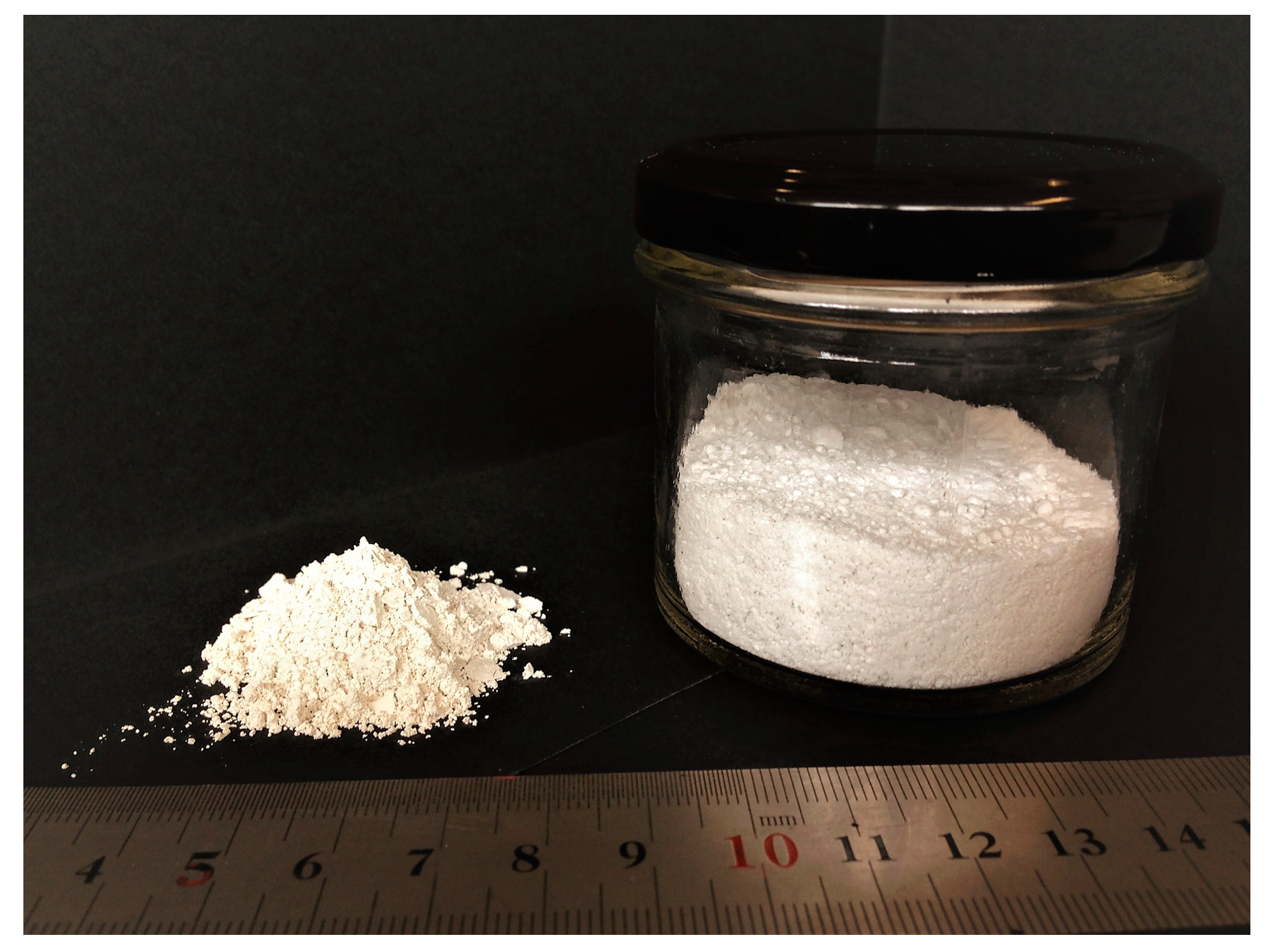
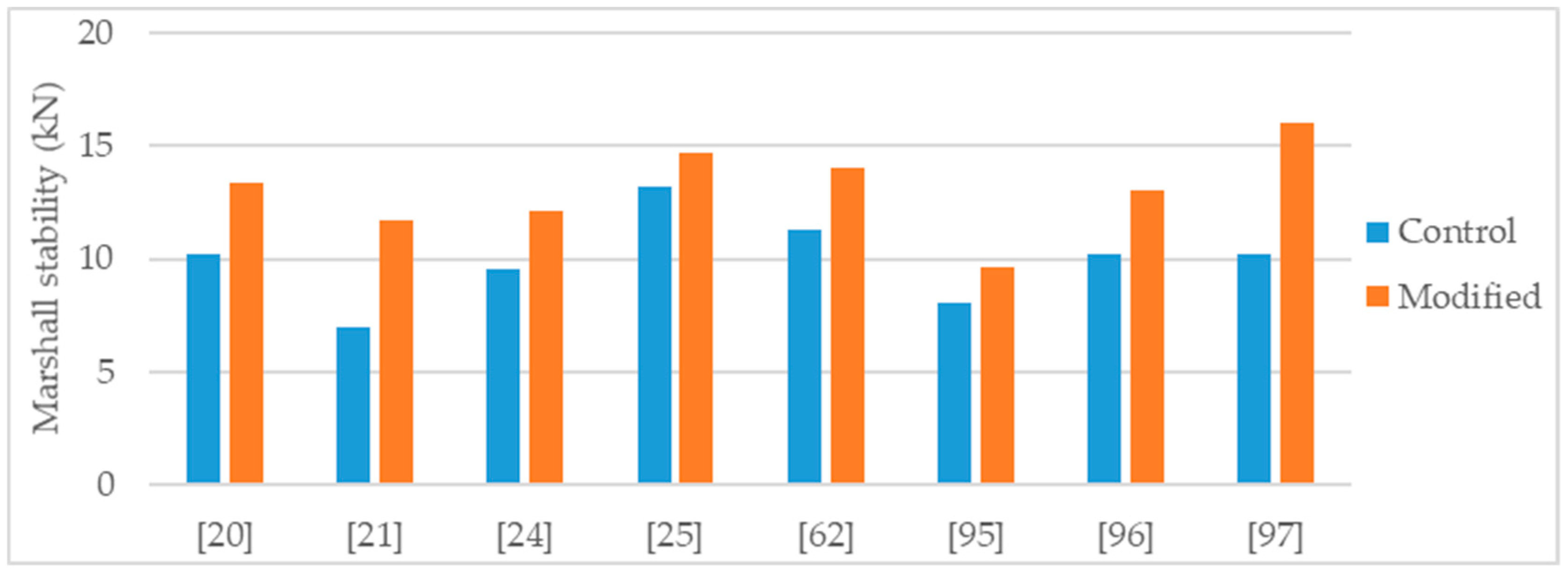
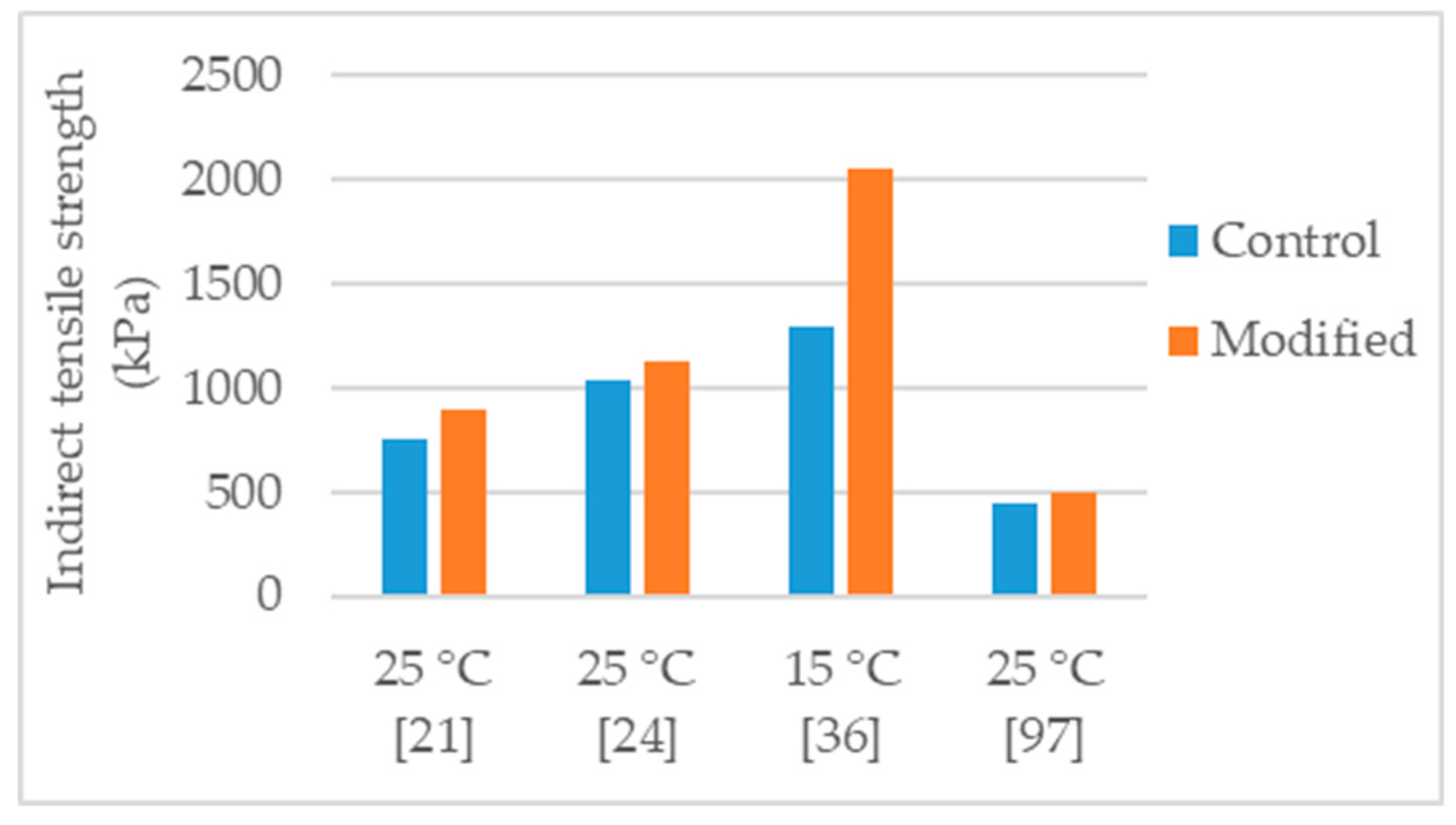
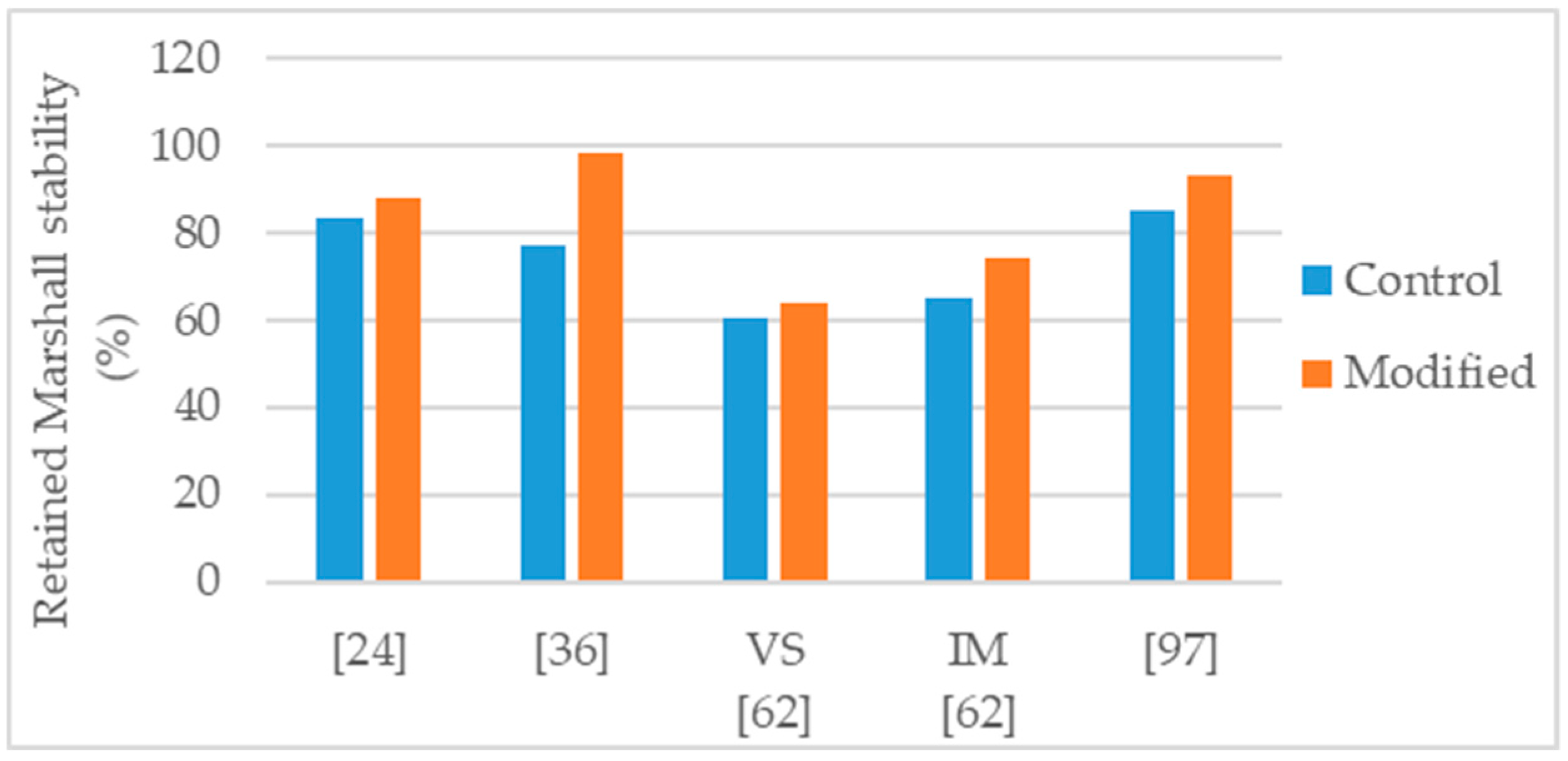

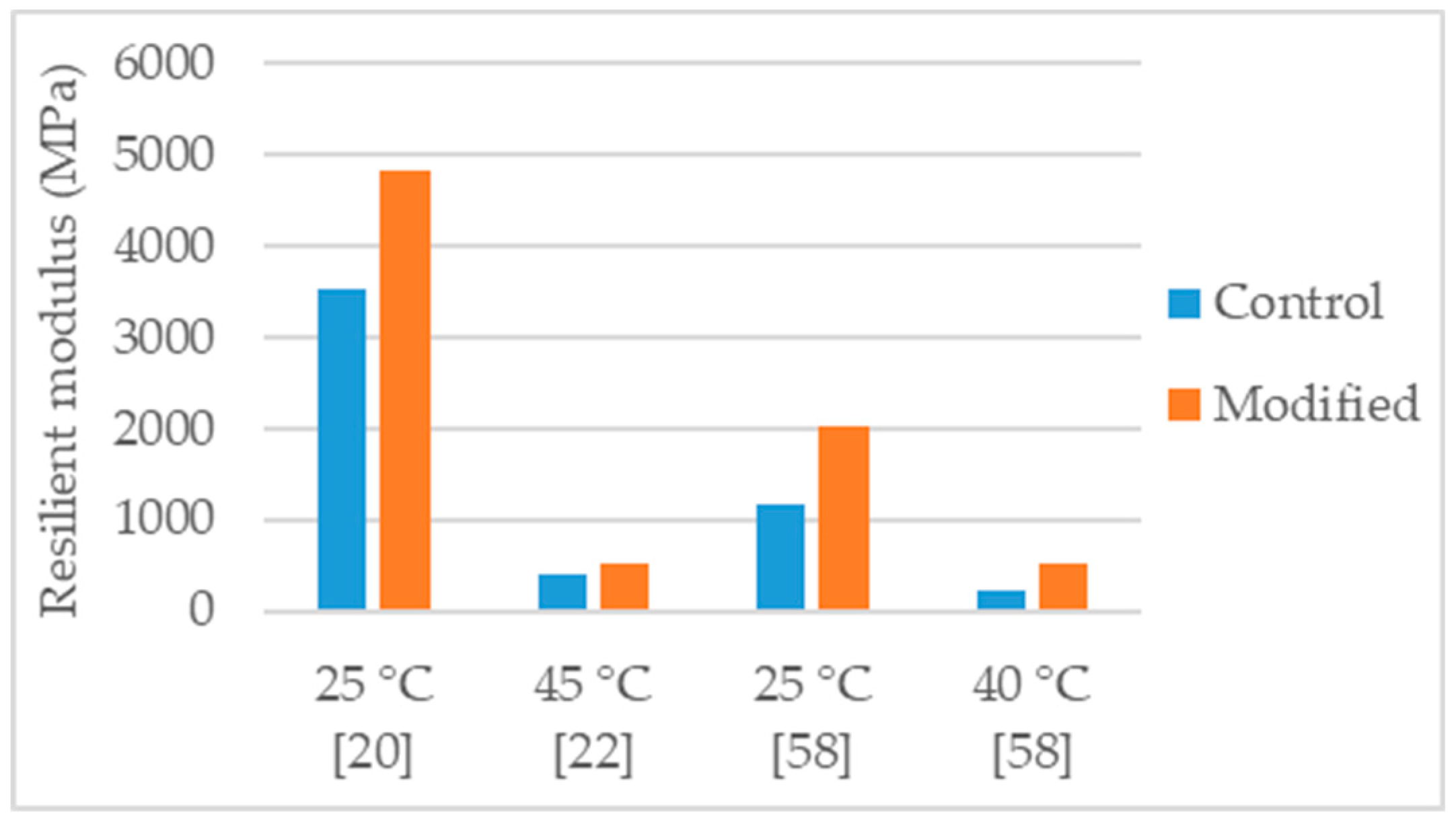
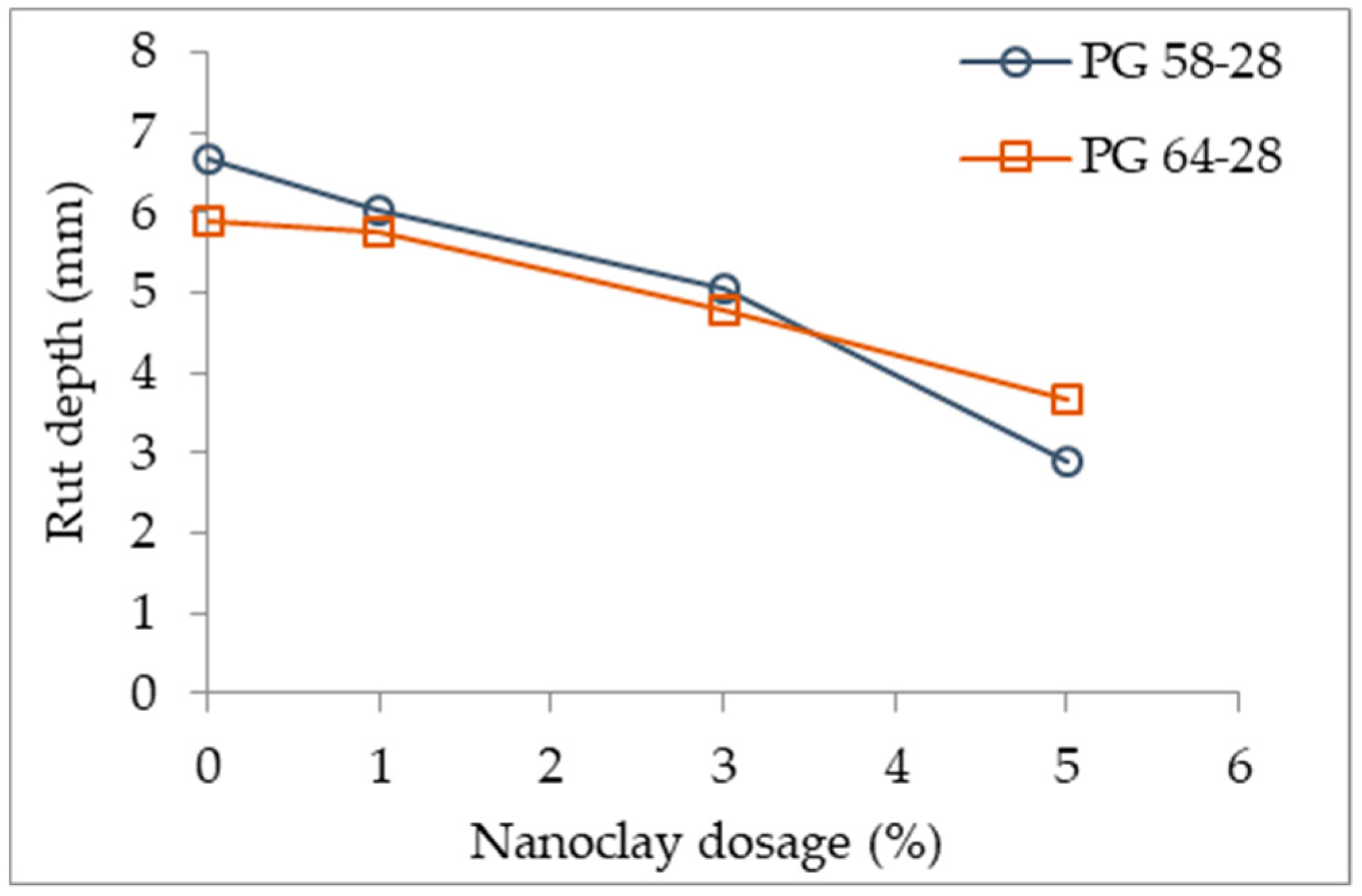
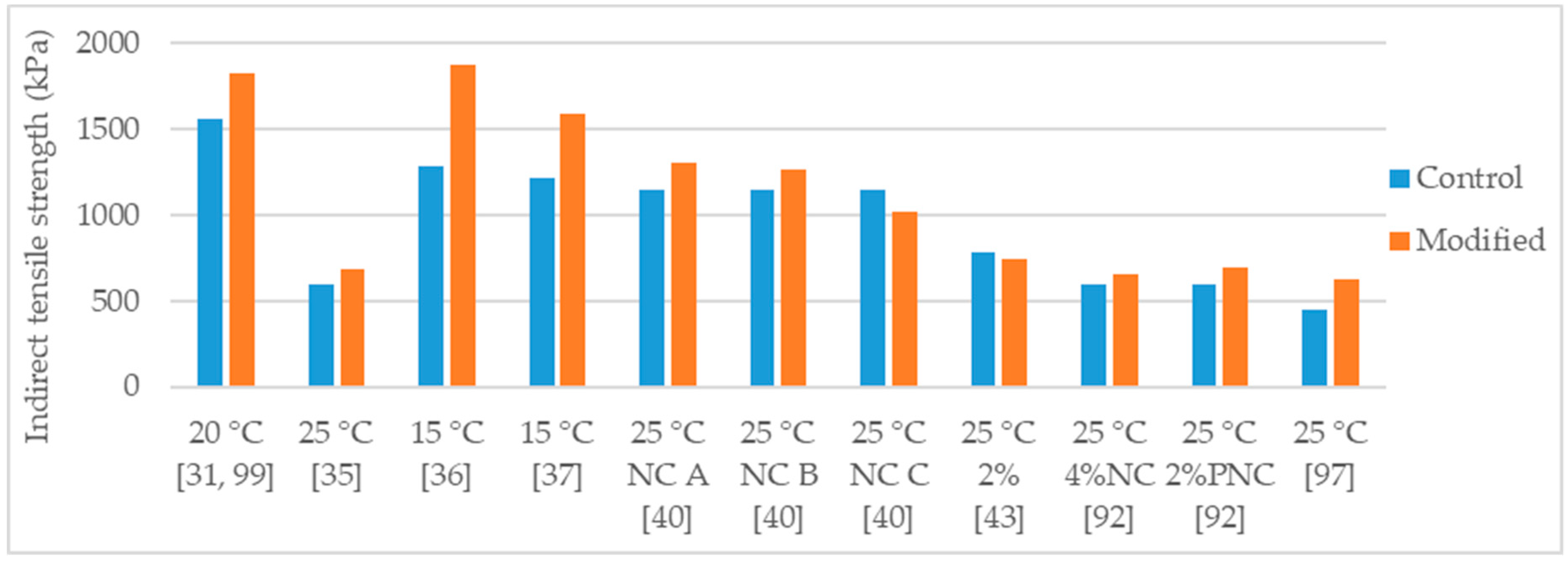
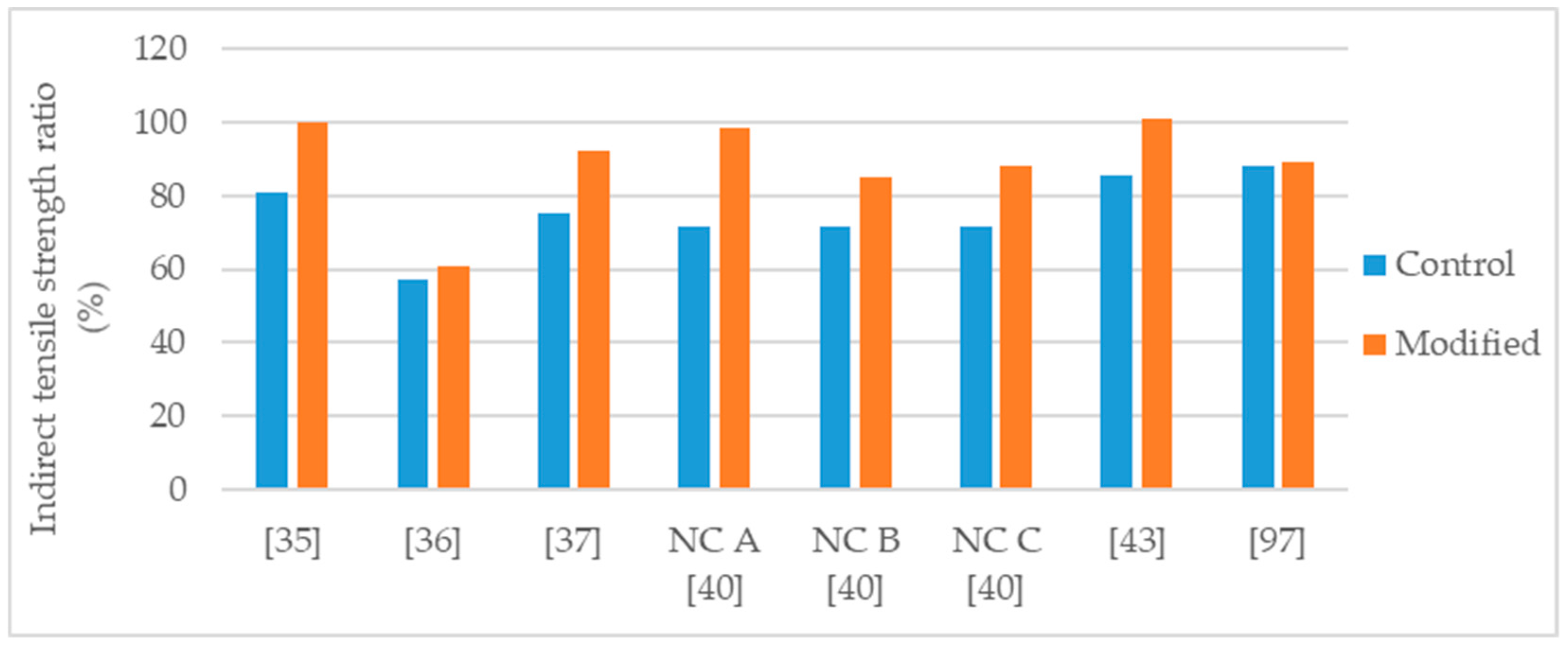
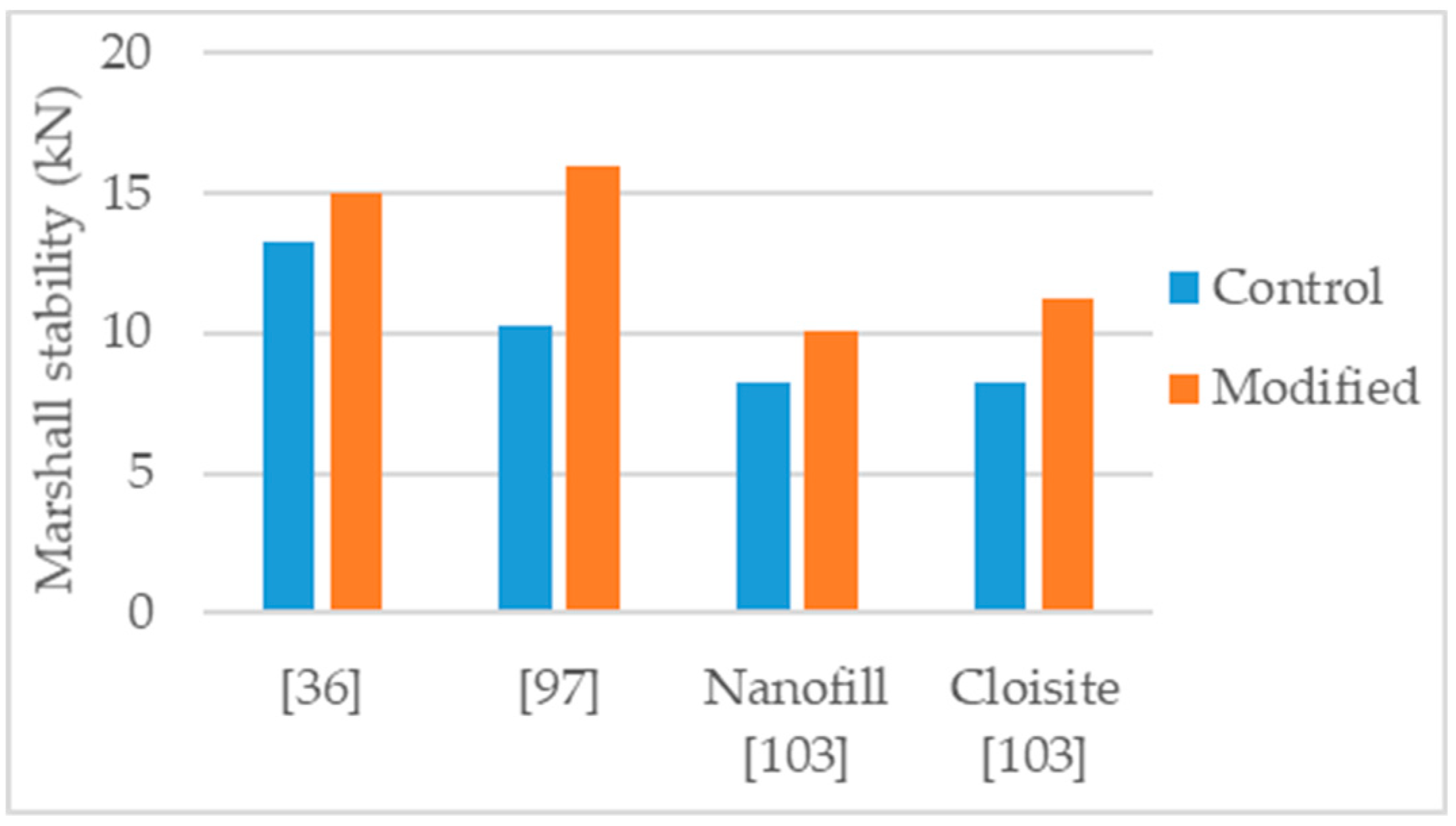

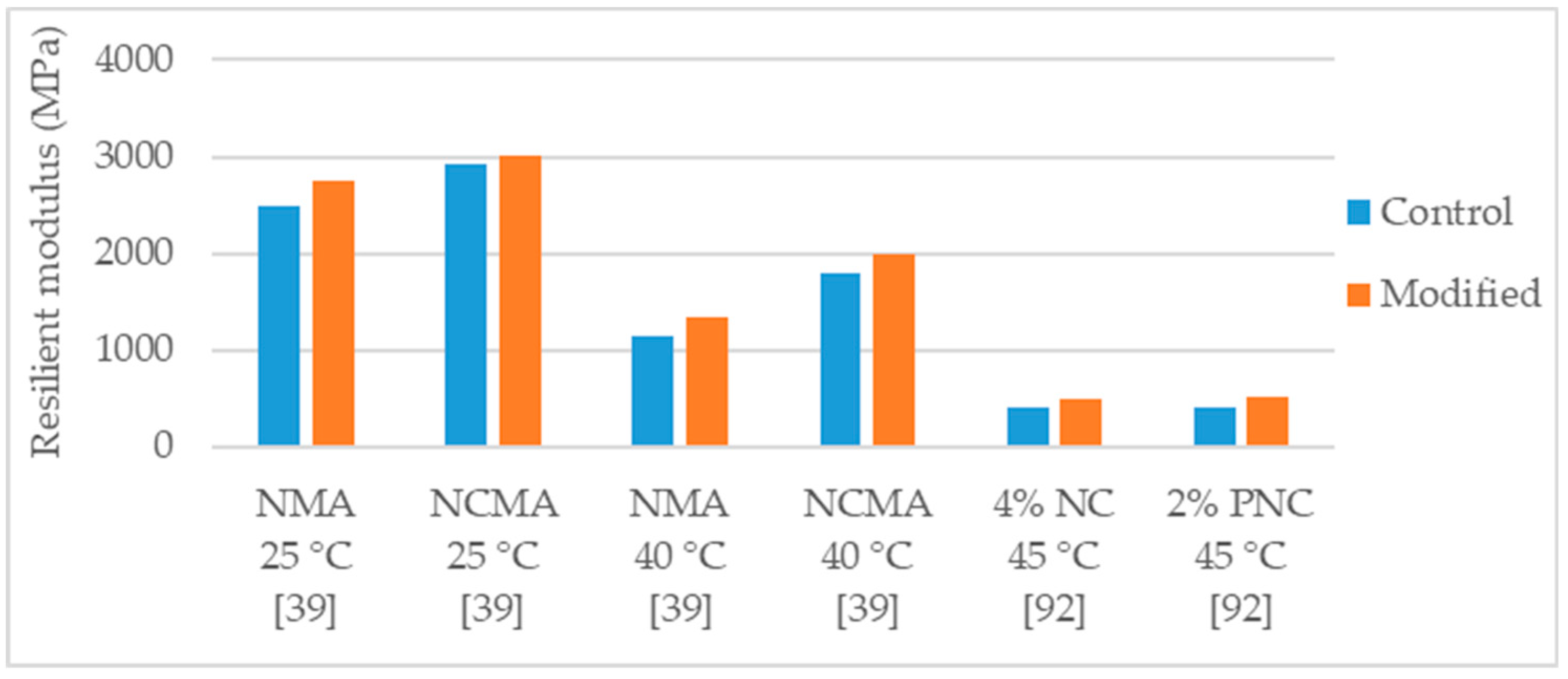
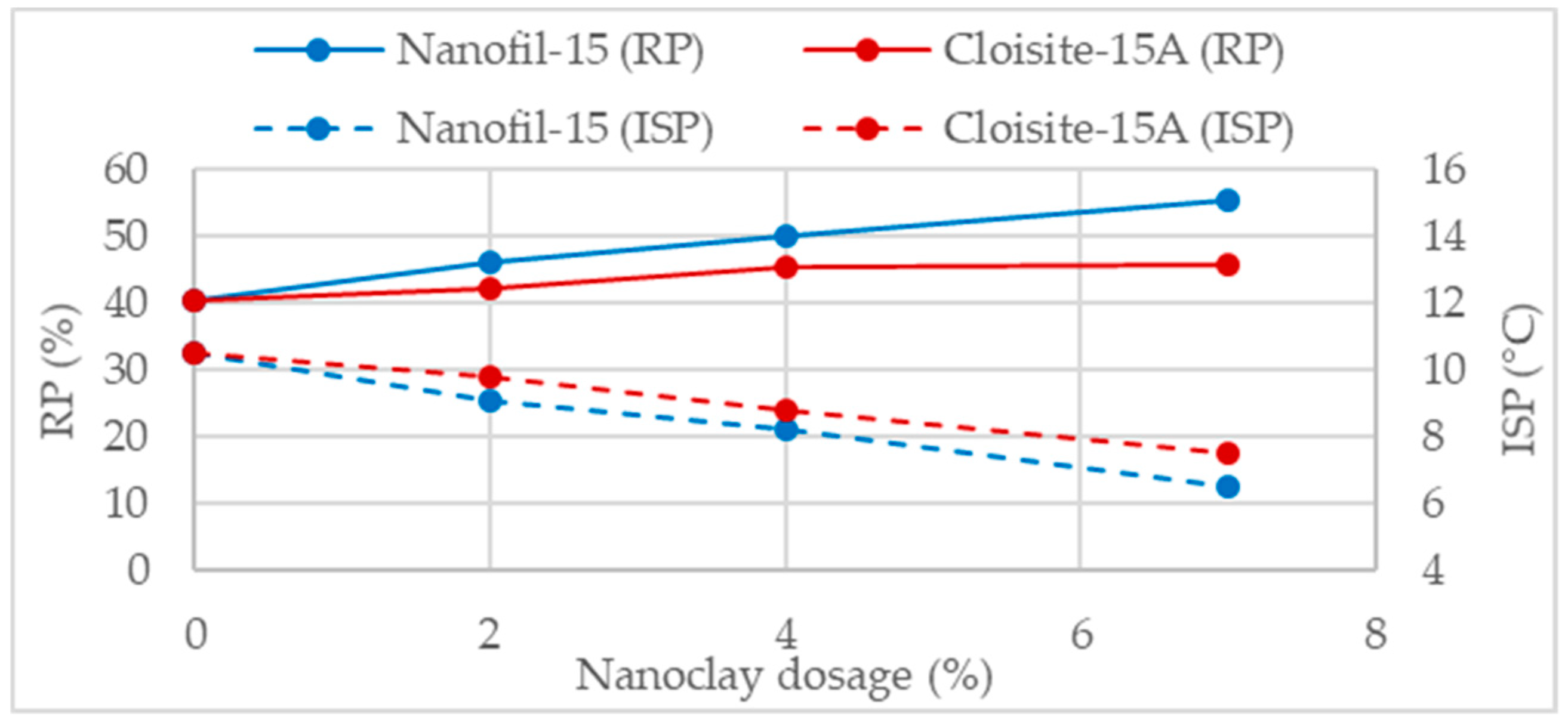
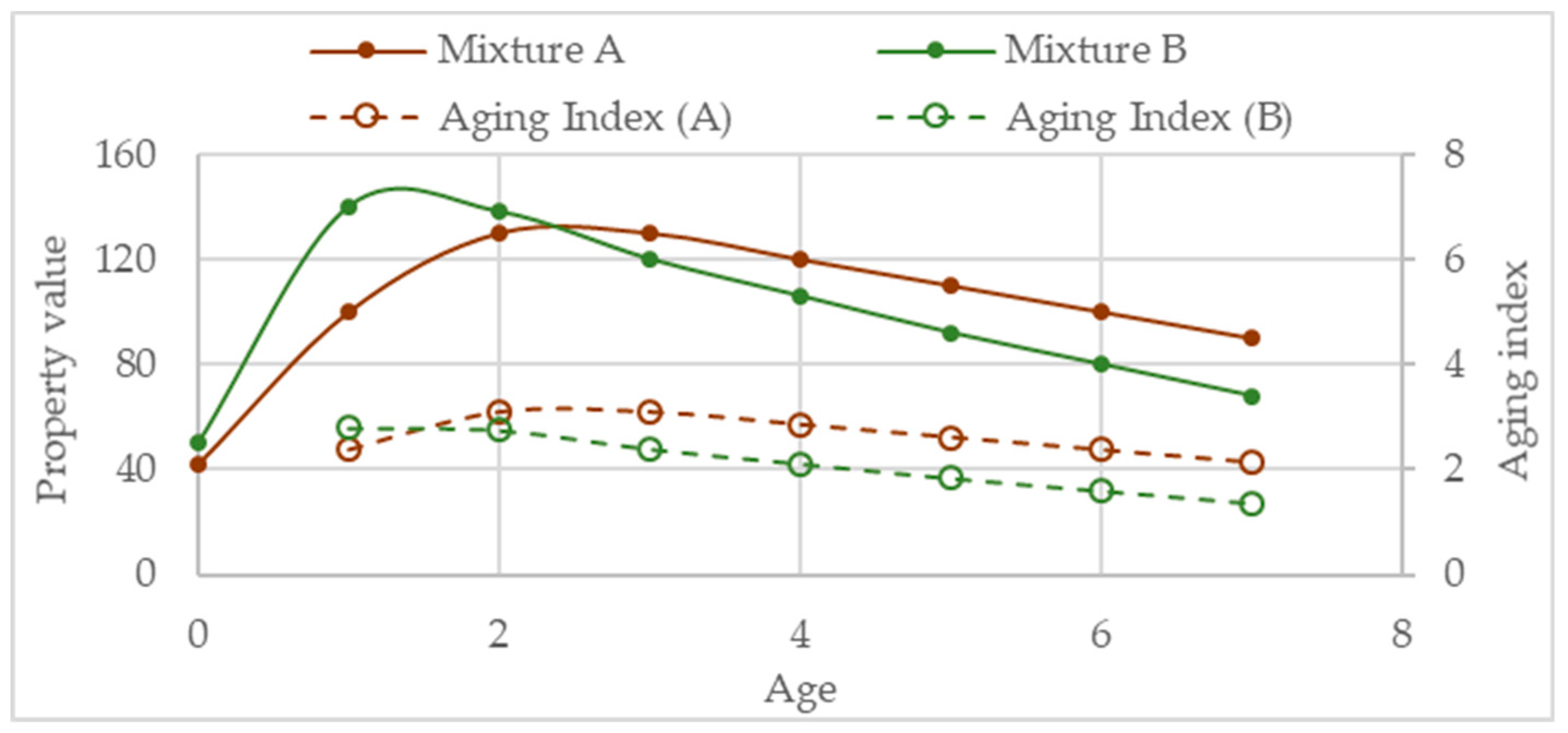
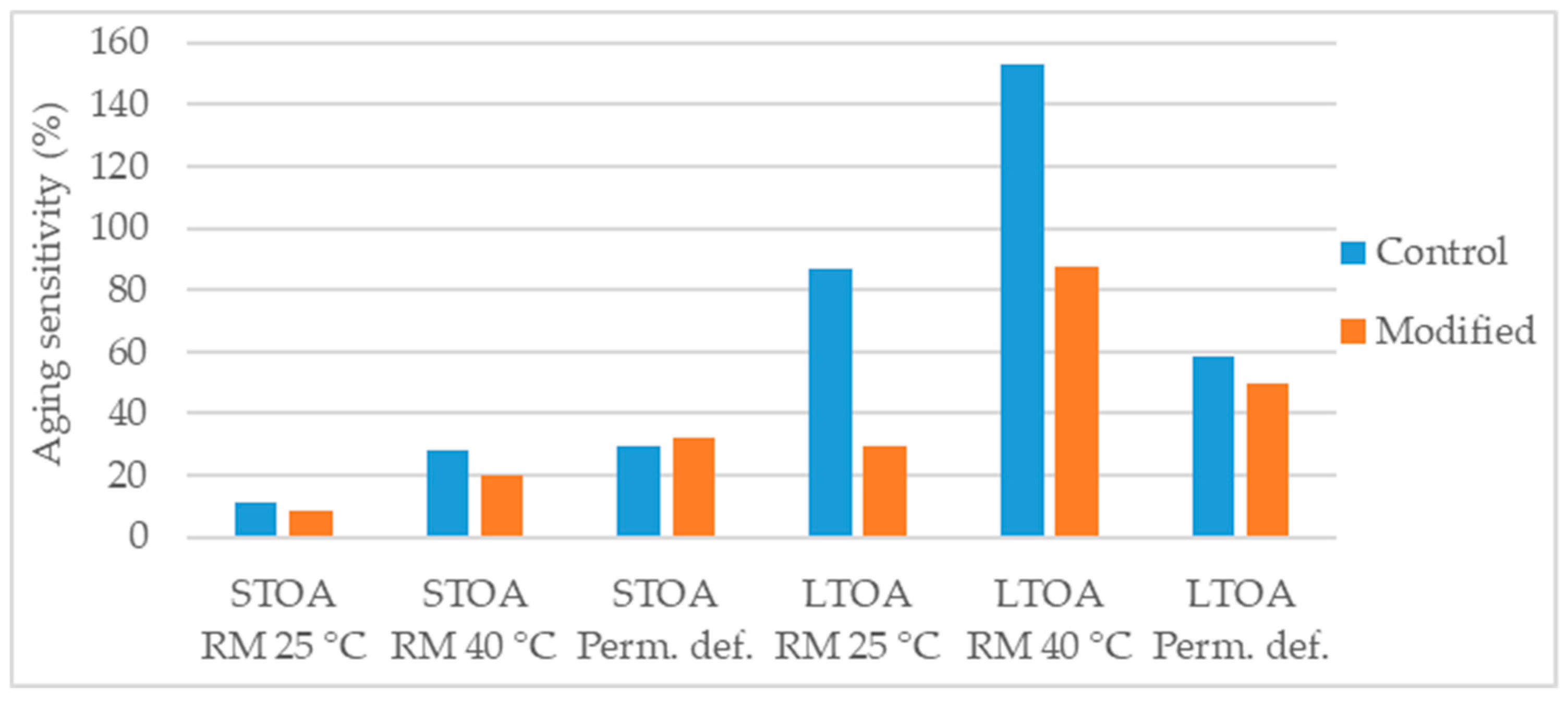
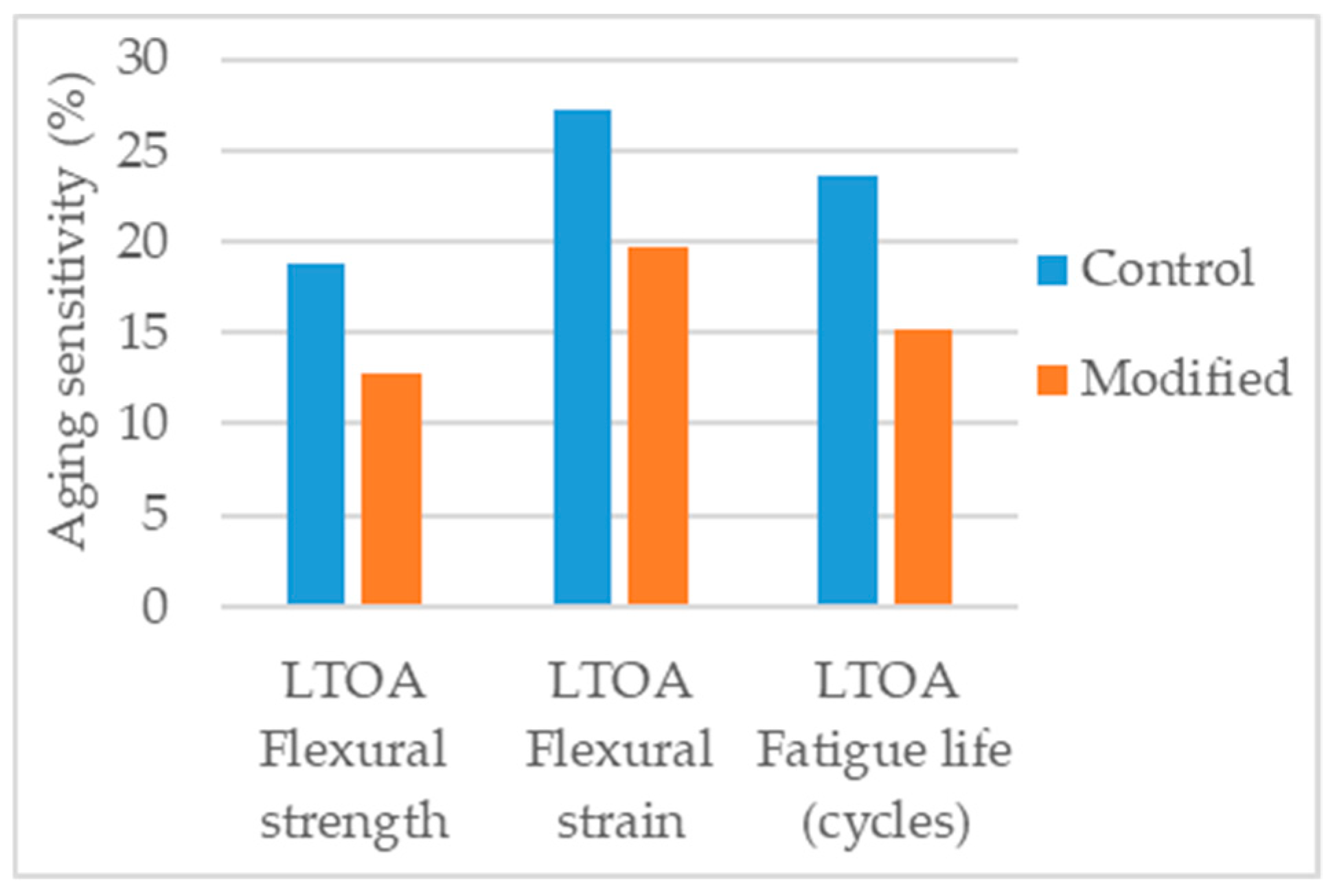
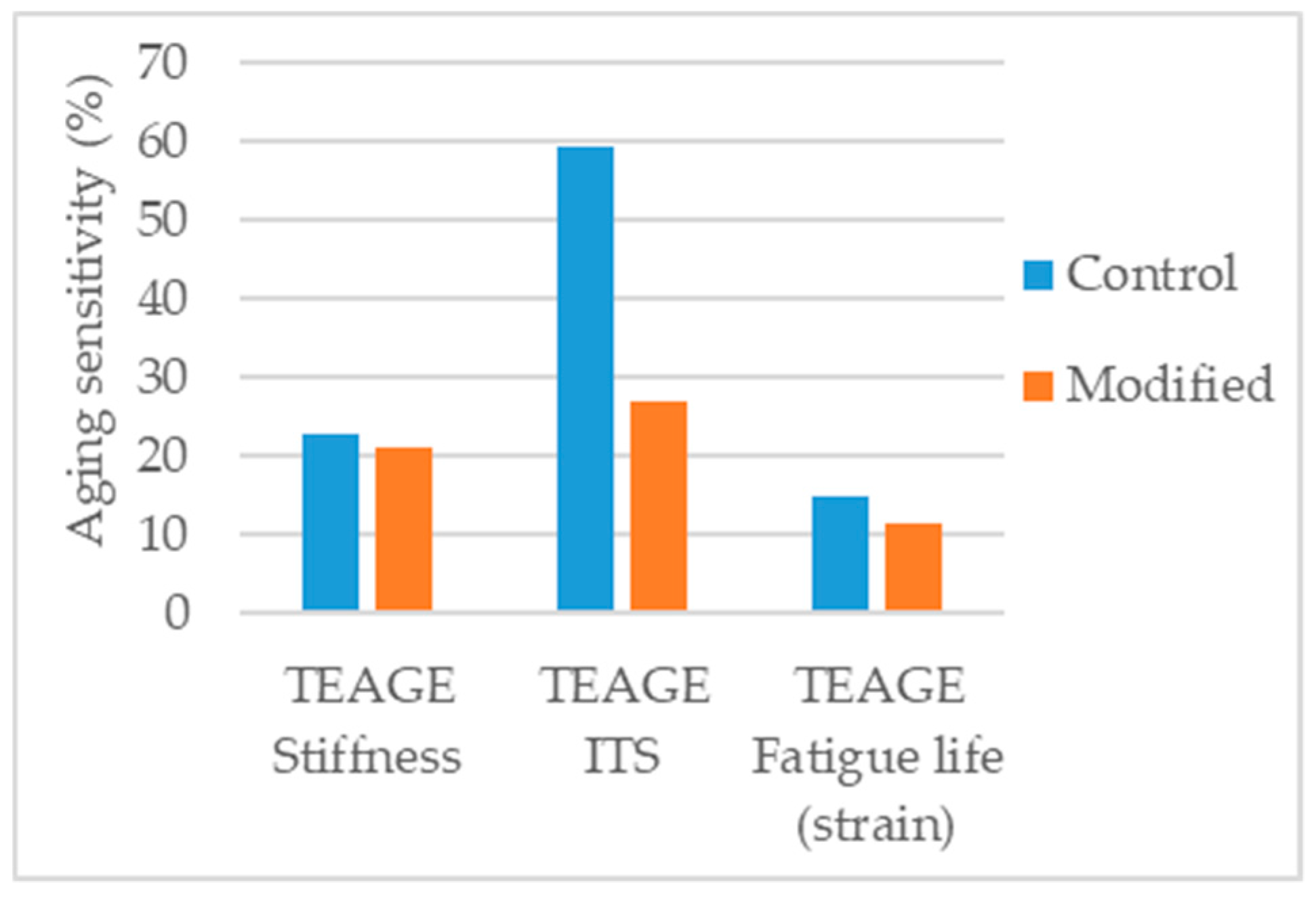
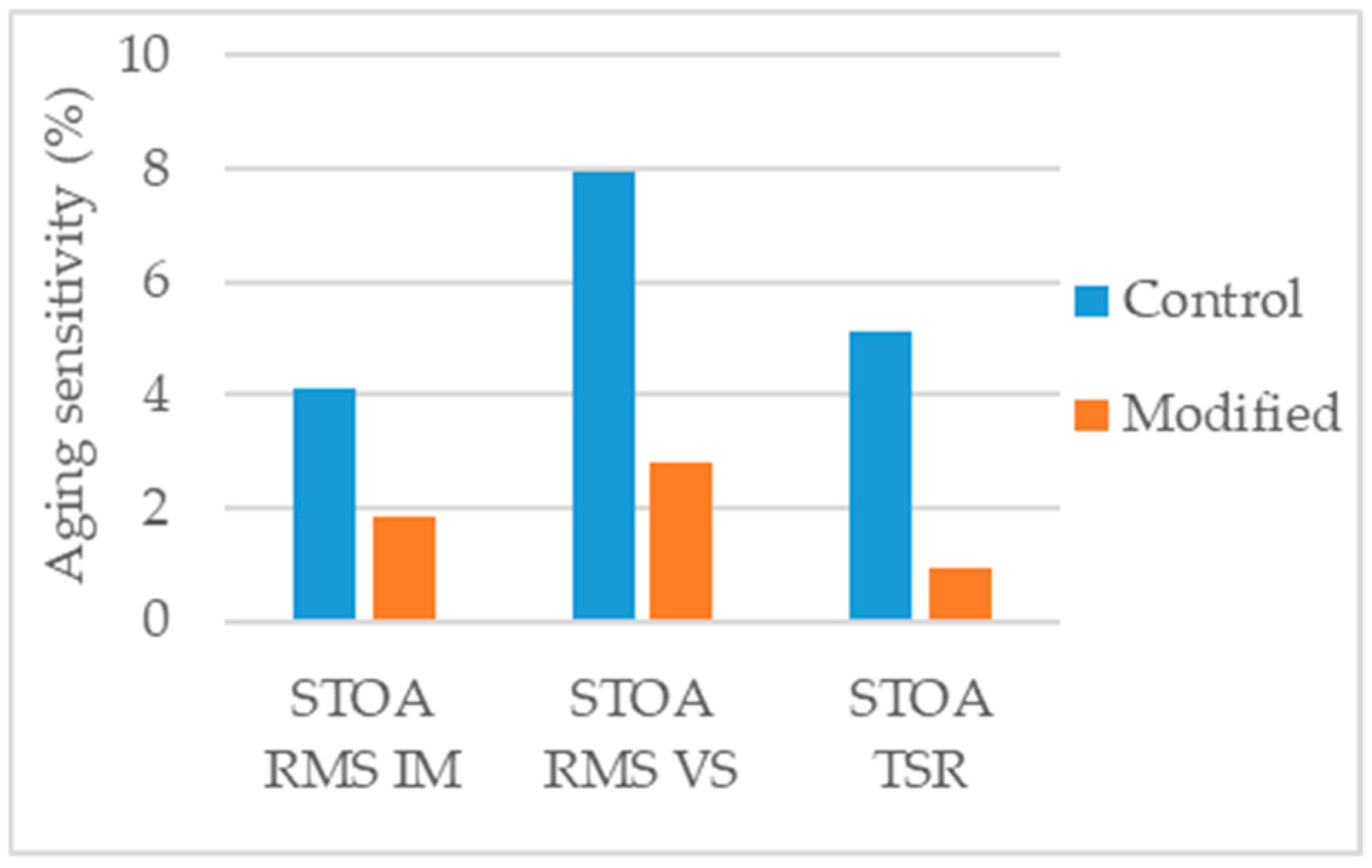
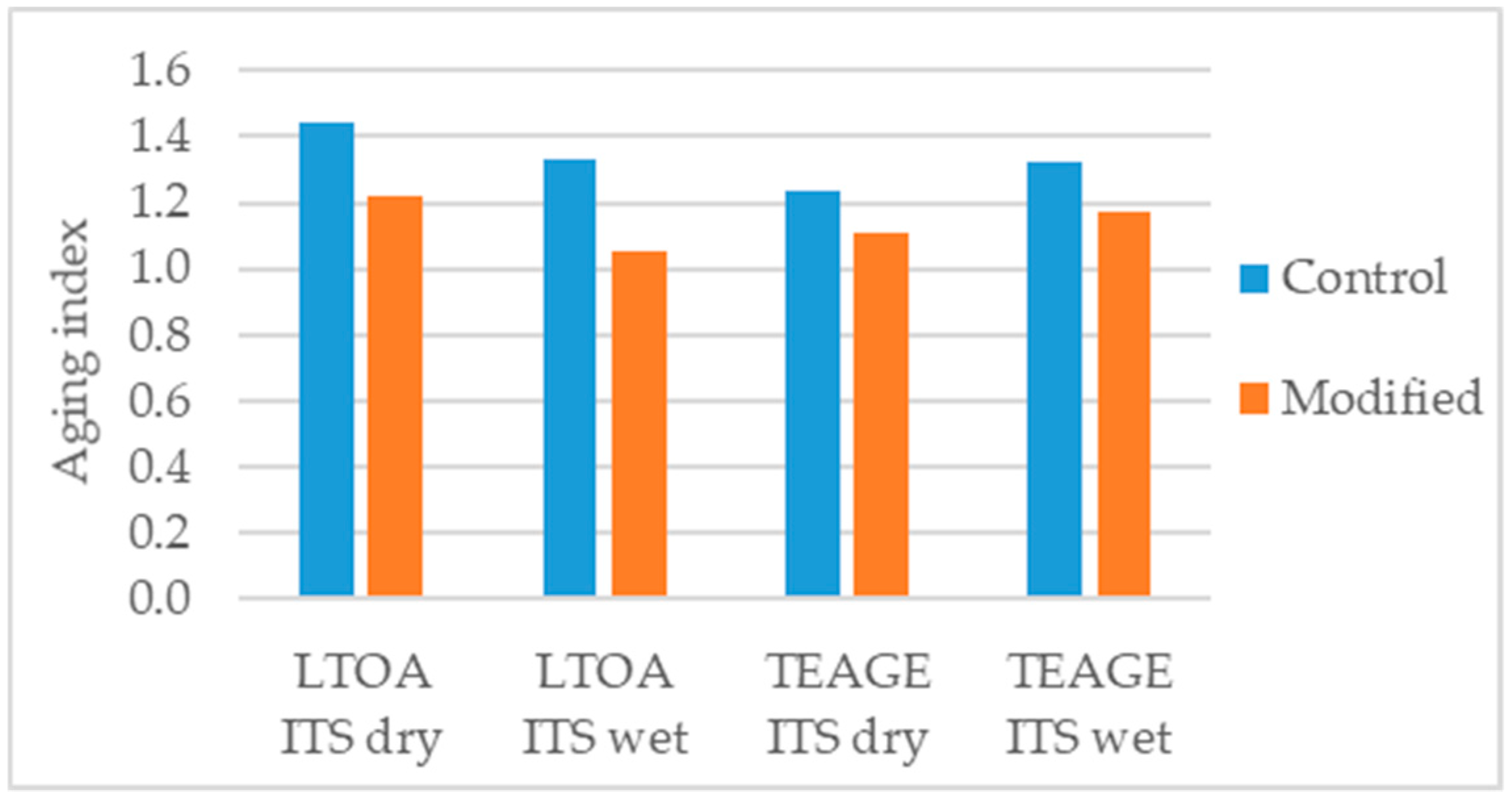


| Particle Size (nm) | Specific Surface Area (m2/g) | True Density (g/cm3) | Bulk Density (g/cm3) | SiO2 (%) | Reference |
|---|---|---|---|---|---|
| 12 | 175–225 | 2.6 | – | ≥99.8 | [17] |
| 20–30 | 130–600 | 2.1 | – | ≥99 | [18] |
| <10 | 600 | 2.4 | 0.10 | ≥99 | [19,20] |
| 15 ± 3 | 160 ± 12 | – | 0.14 | ≥99.9 | [21] |
| 30 | 440 | – | 0.063 | – | [22] |
| 20–30 | 180–600 | 2.4 | – | 99 | [23] |
| 30 | 200 ± 35 | – | 0.03-0.06 | 99.8 | [24] |
| 70 | 64 | 2.2–2.6 | – | – | [25] |
| Designation | Type | Modifier | Bulk Density (g/cm3) | Reference |
|---|---|---|---|---|
| Cloisite-15A | Organophilic | Methyl, tallow, bis-2-hydroxyethyl, quaternary ammonium | 0.230 | [34] |
| Nanofil-15 | Organophilic | Nanodispers layered silicate, long chain hydrocarbon | 0.190 | [34] |
| Organophilic nanoclay | Organophilic | dimethyl ammonium with two alkyl chains | – | [35] |
| Bentonite | Hydrophilic | – | – | [36,37] |
| NMN | Hydrophilic | – | 0.678 | [38] |
| PMN | Organophilic | Polysiloxane | 0.251 | [38] |
| Cloisite 15A | Organophilic | Quaternary ammonium salt | – | [39] |
| Nanoclay A | Organophilic | Na-activated; Dimethyl, dehydrogenated tallow, quaternary ammonium | – | [40] |
| Nanoclay B | Organophilic | Na-activated; Methyl, tallow, bis-2-hydroxyethyl, quaternary ammonium | – | [40] |
| Nanoclay C | Organophilic | Dimethyl, benzyl, Na-activated; hydrogenated tallow, quaternary ammonium | – | [40] |
| BT | Hydrophilic | – | – | [41,42] |
| OBT | Organophilic | octadecylammonium salt | – | [41,42] |
| Nanoclay | Organophilic | Polysiloxane | 0.251 | [43] |
| Type | Particle Size (nm) | Specific Surface Area (m2/g) | Purity (%) | Reference |
|---|---|---|---|---|
| Fe | 50 | 25 | >80 | [36] |
| Fe2O3 | 38 | – | – | [49] |
| Fe2O3 | 20–40 | 40–60 | >98 | [50] |
| Modification | Neat Binder | Temperature (°C) | Rotation Speed (rpm) | Duration (min.) | Reference |
|---|---|---|---|---|---|
| 2%, 4% SiO2 | PG 76 PM | 160 | 1500 | 60 | [58] |
| 3% OMMT | PG 58-22 | 150 | 5000 | 100 | [35] |
| 4% SiO2; 4% ZVI; 4% BT | 35/50 | 160 | 2000 | 60 | [25] |
| 0.5%, 1% CNT; 3%, 6% NC | PG 58-22 | 150 | 1550 | 90 | [59] 1 |
| 2% CNT | PG 58-22 | 150 | 5000 | 100 | [60] |
| 3%, 5%, 7% NC; 3%, 5%, 7% NSF; 3%, 5%, 7% NSH | PG 52 (50/70) | 145 | 1500 | 60 | [27] |
| 0.5%, 1% CNT; 3%, 6% NC | 70/100 50/70 | 150 | 1550 | 90 | [61] 1 |
| 2%, 4% OMMT | PG 64-28 | 160 | 2500 | 180 | [55] |
| 2%, 4% NMN; 2%, 4% PMN | PG 58-34 | 130 | 4000 | 120 | [38] |
| 2% to 8% SiO2 | 60/70 | 135 | 4000 | 120 | [19,20] |
| 0.5% to 5% SiO2 | 70/100 | 160 | 4000 | 60 | [62] |
| 1.5% OMMT | PG 58-10 | 180 | 4000 | 45 | [39] |
| 5%, 10% CBNP | PG 58-22 | 158 | 2800 | 45 | [63] |
| 4% SiO2; 4% TiO2; 4% CaCO3 | 60/70 | 160 | 6000 | 60 | [64] |
© 2019 by the authors. Licensee MDPI, Basel, Switzerland. This article is an open access article distributed under the terms and conditions of the Creative Commons Attribution (CC BY) license (http://creativecommons.org/licenses/by/4.0/).
Share and Cite
Crucho, J.; Picado-Santos, L.; Neves, J.; Capitão, S. A Review of Nanomaterials’ Effect on Mechanical Performance and Aging of Asphalt Mixtures. Appl. Sci. 2019, 9, 3657. https://doi.org/10.3390/app9183657
Crucho J, Picado-Santos L, Neves J, Capitão S. A Review of Nanomaterials’ Effect on Mechanical Performance and Aging of Asphalt Mixtures. Applied Sciences. 2019; 9(18):3657. https://doi.org/10.3390/app9183657
Chicago/Turabian StyleCrucho, João, Luís Picado-Santos, José Neves, and Silvino Capitão. 2019. "A Review of Nanomaterials’ Effect on Mechanical Performance and Aging of Asphalt Mixtures" Applied Sciences 9, no. 18: 3657. https://doi.org/10.3390/app9183657
APA StyleCrucho, J., Picado-Santos, L., Neves, J., & Capitão, S. (2019). A Review of Nanomaterials’ Effect on Mechanical Performance and Aging of Asphalt Mixtures. Applied Sciences, 9(18), 3657. https://doi.org/10.3390/app9183657








